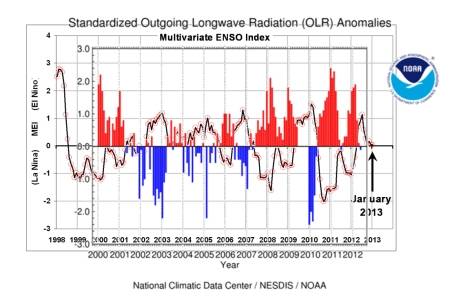- Banned
- #1
El Nino could bring more record-breaking weather to United States - CBS News
A giant El Nino is expected this year, new weather models predict. It threatens to change weather patterns around the world, affecting billions of people.
An El Nino - meaning in Spanish "the little boy, or Christ child" - is created when the equatorial waters of the Pacific Ocean warm significantly.
Significant, in this case, is just a half-degree Celsius. However, according to Time magazine senior writer Bryan Walsh, who covers energy and environmental issues, that's a lot, considering the Pacific's size.
Walsh explained on "CBS This Morning," "Over the course of a number of months, that actually changes weather patterns around the world, has a number of effects that are different in different parts of the world but generally result in a lot of warming, a lot of rain in some places, a lot of drought elsewhere and really just can have a lot of impact."
The last significant El Nino was in 1998, which was one of the warmest years on record.
An El Nino may bring rainfall that could bring long-term relief for some drought-ridden states, such as California. CBS NEWS
One of the most significant areas of damage that year involved massive damage to crops in South and Central America.
"You saw billions of dollars in damages from that El Nino," Walsh said. "You could see a similar amount from this one as well."
However, it's not all bad news during an El Nino year. Fewer hurricanes in the Atlantic and more rainfall may happen in the U.S. - a boon for drought-ridden areas, such as California and Texas.
Walsh explained that El Ninos are a separate phenomenon from climate change but, according to some research, El Ninos may be more common in a warmer future.
Overall, the El Nino may just add to the Earth's warmth. He said, "We may have a year where 2014 or 2015 could become perhaps the warmest year on record when you add the effect of El Nino to the warming that's already happening."
A giant El Nino is expected this year, new weather models predict. It threatens to change weather patterns around the world, affecting billions of people.
An El Nino - meaning in Spanish "the little boy, or Christ child" - is created when the equatorial waters of the Pacific Ocean warm significantly.
Significant, in this case, is just a half-degree Celsius. However, according to Time magazine senior writer Bryan Walsh, who covers energy and environmental issues, that's a lot, considering the Pacific's size.
Walsh explained on "CBS This Morning," "Over the course of a number of months, that actually changes weather patterns around the world, has a number of effects that are different in different parts of the world but generally result in a lot of warming, a lot of rain in some places, a lot of drought elsewhere and really just can have a lot of impact."
The last significant El Nino was in 1998, which was one of the warmest years on record.
An El Nino may bring rainfall that could bring long-term relief for some drought-ridden states, such as California. CBS NEWS
One of the most significant areas of damage that year involved massive damage to crops in South and Central America.
"You saw billions of dollars in damages from that El Nino," Walsh said. "You could see a similar amount from this one as well."
However, it's not all bad news during an El Nino year. Fewer hurricanes in the Atlantic and more rainfall may happen in the U.S. - a boon for drought-ridden areas, such as California and Texas.
Walsh explained that El Ninos are a separate phenomenon from climate change but, according to some research, El Ninos may be more common in a warmer future.
Overall, the El Nino may just add to the Earth's warmth. He said, "We may have a year where 2014 or 2015 could become perhaps the warmest year on record when you add the effect of El Nino to the warming that's already happening."



